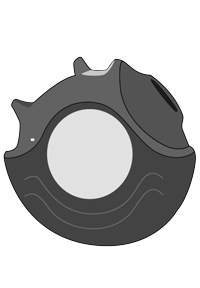Serevent® Diskus®
This product is manufactured by GlaxoSmithKline using the ingredient salmeterol xinafoate.
This product is inhaled into the lungs using the Diskus®.

play
Diskus®
Why is it prescribed?
Salmeterol is used on a regular basis to prevent bronchospasm associated with asthma, chronic obstructive pulmonary disease (COPD), bronchitis, emphysema and other pulmonary disorders where bronchospasm is a complicating factor. In asthma, salmeterol is an optional add-on therapy for those having poor asthma control despite an optimal dose of inhaled corticosteroids (ICS) and short-acting bronchodilators. Salmeterol may also be used as first-line therapy in people with chronic obstructive pulmonary disease.
- The Serevent® Diskus® is intended for inhalation only.
- Each dose of Serevent® is a measured quantity of dry powder that is contained in a small foil blister in the delivery device known as a diskus. The diskus contains 60 doses and has a counter that tells you the number of remaining doses. It counts down from 60 to 1. When the last five doses have been reached, the numbers appear in red to indicate that you are due for another Serevent® refill.
- Your doctor or pharmacist should have instructed you on the proper use and care of your Serevent® Diskus®. It is advisable to have your technique reassessed by the pharmacist for the first 2 or 3 refills of your prescription.
- It is very important to keep your diskus dry and closed when not in use, and never breathe into your diskus. Do not store Serevent® at temperatures above 30°C.
Alternatives
Other products that have the same ingredient as Serevent® Diskus® are •Advair® Diskus® •Advair® MDI •PMS-Fluticasone Propionate/ Salmeterol DPI •Wixela® Inhub® •
See other products used in the treatment of •asthma •bronchitis •bronchospasm associated with COPD •chronic bronchitis (COPD) •COPD •emphysema (COPD) •
Asthma: The usual dose in adults and children over 4 years of age is 1 blister (50 mcg) by oral inhalation twice daily (1 blister in the morning and 1 blister in the evening).
COPD: Adults - 1 blister (50 mcg) by oral inhalation twice daily
Salmeterol is a long-acting bronchodilator that acts at specific receptors called beta2-adrenergic receptors. It works by relieving spasm or narrowing in the small air passages in the lungs causing chest tightness and wheezing. This helps to open up the airways and makes it easier for air to get in and out of the lungs. When it is taken regularly, it helps the small air passages stay open.
Along with its needed effects, salmeterol may cause some unwanted or undesirable effects. Often, salmeterol users who use their medication properly, never experience any unwanted effects. The severity and duration of these effects are dependant on many factors including duration of therapy, dose, route of administration and individual response.Possible unwanted effects include:
- headache
- feeling a little shaky
- slight palpitations (awareness of heart beat)
Uncommon:
- increased heart rate
- increase in the amount of sugar (glucose)
- dizziness
- nausea
- muscle cramps
- trouble sleeping
- weakness
- drowsiness
- flushing
Rare:
- restlessness
- irritability
- vertigo (whirling sensation)
- unusual taste
- chest discomfort
- angina (chest pain)
Many of these unwanted effects, especially the most common ones, may disappear with continued use. Check with the doctor or pharmacist if any of them continue or become bothersome.
- In asthma, salmeterol must be used together with an appropriate dose of inhaled corticosteroid and salmeterol should never be used as rescue medication.
- Maximum benefit cannot be achieved if the device is not used correctly. Even if you have used the device before, you should have your technique reassessed by your pharmacist and read the patient instructions that are provided with each product.
- Salmeterol's bronchodilating effect lasts 12 hours. It should be used on a regular basis, every morning and evening (every 12 hours) and never more frequently than this. Breakthrough symptoms should be treated with a short-acting (rescue) bronchodilator.
- If your rescue medication isn't working as well as it used to, or if you need more inhalations than usual to control breakthrough symptoms, your asthma may be worsening and your condition should be reassessed by your doctor.
- Never adjust doses of salmeterol or any other asthma medications you are taking without consulting the doctor.
- Using 2 or more inhaled medications can lead to confusion. Ensure that you know what each one is for and when they should be used.
- Salmeterol is intended for long-term treatment and should not be started in people whose asthma is worsening or unstable.
Drug Interactions: Be sure to tell your doctor and pharmacist about any prescription or over-the-counter medications you are taking in order to avoid any potential drug interactions. The following drugs and drug classes have been known to interact with salmeterol:
- MAO (monoamine oxidase) inhibitors (e.g. phenelzine, tranylcypromine)
- tricyclic antidepressants (e.g. amitriptyline)
- some beta-blockers (e.g. propranolol)
- other bronchodilators
Use is not recommended in the following situations:
- allergy to salmeterol or any component of the preparation
- allergy to lecithin, soya or related products (e.g. soyabeans), milk or lactose
- cardiac arrhythmia (irregular hear beat) associated with tachycardia (rapid heart rate)
- people whose asthma is managed by occasional use of short- acting bronchodilators
- children under 4 years of age
Caution recommended in the following situations:
- high blood pressure
- diabetes
- heart disease
- seizures (history)
- elderly
- sensitivity to sympathomimetics (drugs that stimulate the central nervous sysytem)
Use in pregnancy: Data is limited. Consult your doctor or pharmacist before use.
Use while breastfeeding: Data is limited. Consult your doctor or pharmacist before use.
